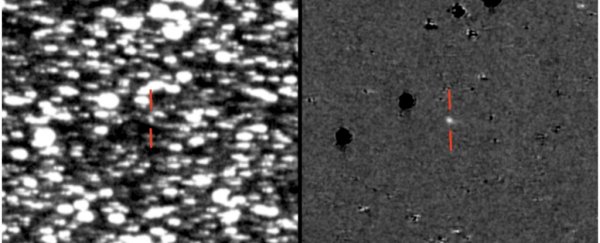Earlier this month, astronomers announced the discovery of something incredible - a brand new type of asteroid… with a tail.
But in an update, the researchers have announced their original classification was incorrect. The strange object is in fact a comet in disguise, although it doesn't really make it any less odd.
So what caused the mix up?
We tend to think of asteroids and comets as pretty strictly delineated categories.
Comets have long, looping orbits and are loaded up with volatile ices that sublimate, generating a dusty, misty halo and tail when the comet comes close to the Sun.
Asteroids, on the other hand, are generally considered rocky, dry and inert, with orbits in the Solar System similar to those of the planets.
Every now and again, though, we come across something that challenges these definitions. And the recently discovered 'asteroid', which was named 2019 LD2, was one of those cases.
It had an asteroid-like orbit, but a comet-like tail. That's rare, but not unknown - we call asteroids that exhibit comet-like characteristics (such as outgassing and sublimation) active asteroids. However, it wasn't the what, but the where that made 2019 LD2 unique.
You see, the object appeared to share its orbit with Jupiter, in an asteroid swarm known as the Jupiter Trojans. And it was thought to be the first Jupiter Trojan astronomers had ever seen spewing out gas like a comet would. Hence the excitement.
However, a follow-up examination - initially prompted by amateur astronomers - has led to the realisation that this isn't a brand new type of asteroid at all. It is in fact a regular comet that has a chaotically changing orbit, which just so happens to currently resemble that of a trojan asteroid.
Or an "interloper comet masquerading as a member of the Trojan population," as a press release from the University of Hawai'i, where the discovery and follow-up was made, calls it.
The comet has since been renamed slightly to P/2019 LD2, and the reclassification was announced in a Minor Planet Electronic Circular on May 22. A follow-up confirmation by an independent astronomer in Japan confirmed the update the following day and was published by the Central Bureau of Astronomical Telegrams.
So what we now know as comet P/2019 LD2 is actually a Jupiter-family comet, a different group of objects to the Trojan population, but also under the influence of Jupiter.
The difference is that true Jupiter Trojan asteroids have orbits that closely follow Jupiter's orbit around the Sun but they're 'clumped' either ahead or behind Jupiter in curved regions centring on the planet's Lagrangian points.
These are spots where the combined gravitational forces of two larger bodies (in this case Jupiter and the Sun) create a small area of gravitational stability.
Jupiter-family comets, on the other hand, have more typical comet-like orbits that can extend from way out beyond Saturn back to the inner Solar System.
Every few decades as comet P/2019 LD2 travels along this orbit, it comes close enough to Jupiter that the gas giant's massive gravitational pull can dramatically change its orbit for a period of time - which is what we're currently seeing and what had astronomers confused.
Despite the disappointment that this object isn't actually a brand new type of asteroid, it's still an incredibly cool discovery, and a beautiful example of science in action.
You can read more about the update here.
This article was updated from the original announcement on May 21.
